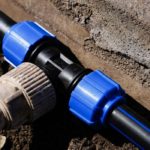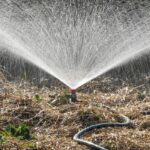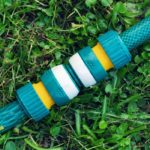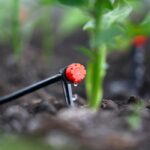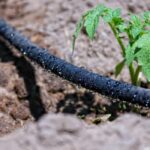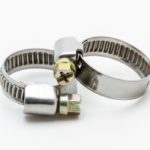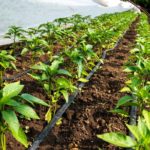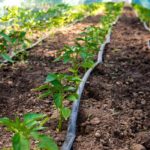For those of us committed to gardening, finding the ideal method to water plants can be challenging. Drip irrigation is an excellent way to save time and resources. It’s one of the most water-efficient ways to irrigate, as it directs water to the specific plant. With drip irrigation, you can provide water to different garden areas, including orchards, flower beds, a patio container garden, and raised garden beds.
Drip irrigation systems are low pressure. When connecting a drip irrigation system to a hose, you have to use a pressure regulator to reduce the city water pressure to something that works in the drip irrigation system (typically ~25psi). Drip irrigation kits will come with the fittings to do this.
The many benefits of drip irrigation make investing in the system well worth it. Let’s look at the advantages drip irrigation offers and what the process of setting drip irrigation up in your lawn or garden entails.
What is Drip Irrigation?

Drip irrigation is a highly efficient water delivery system you can use to grow crops, water grass, or simply water hanging baskets and plants. It sends nutrients and water directly to the plant’s root area, ensuring the right amount is released at the right time. This allows each plant to receive the precise amount it needs to thrive. This enables you to get higher yields or healthier plants while spending a lot less water and energy.
The process is simple: plastic tubing distributes water wherever you want it to, via simple drippers or sprayers (both on Amazon). The spaces between the plants are not watered, which minimizes the chance of weeds sprouting where you don’t want them and reduces water waste.
Some drip irrigation systems can be optimized to only release the right amount of water at certain times. If you’re looking to save time and keep your lawn in good shape, an automated system is ideal. This is one of the best ways to irrigate, as the costs are low once you set up the system.
What Are the Advantages of a Drip Irrigation System?
So, what are some of the reasons you should choose drip irrigation over other methods? These are some of the top benefits you enjoy when you use a drip irrigation system:
Reduced Water Usage
Because the drip irrigation system applies water directly to the root zone, it helps save water. Water is only applied to the areas that benefit the plant. Other methods like a sprinkler spread water over a large area indiscriminately, with most of the water going to waste.
Healthier Foliage
With overhead watering, the leaves of the plant remain wet after irrigating. This can cause discoloring and spotting. The drip method ensures the plant leaves remain dry and healthy.
Prevent Fungus
When the leaves get wet, this can cause the spread of fungus like powdery mildew. Using drip irrigation, you can keep the foliage dry, which prevents fungus.
No Soil Erosion
Another big reason to use drip irrigation is that the method is gentle and steady. It regulates the amount of water released into the soil, preventing soil erosion.
Helps Fight Weeds
Because drip irrigation doesn’t water areas between crops, you will not need to deal with too many weeds. The water only goes to the zone near the roots of the plant.
Minimal Nutrient Runoff
When you have a large volume of water flowing into the soil, it can deplete nutrients. Drip irrigation reduces runoff and helps with nutrient retention.
What Supplies Do I Need for Drip Irrigation?
To get started with the installation of the drip system, you’ll need several supplies. Here are the main components required.
Nearby Hose Bibb
You can connect the assembly to a garden hose if you want to extend the distance, but a hose bibb is required for anything within 50 feet from the area you want to irrigate.
Pressure Reducer/Connection to Hose Bibb or Hose
This is designed to connect the irrigation system to the hose bibb. It’s a very important component, as the adapter contains a pressure regulator and a filter. Some adapters also come with a backflow preventer. The drip irrigation system is not meant to work under high pressure, so the adapter reduces it. The filter ensures debris doesn’t enter the system, which causes clogging.
A drip irrigation kit (on Amazon) will come with the pressure reduce and hose bib connector, but it’s worth noting that you don’t have to put this connection at the hose bib itself – you can (and probably should) run a normal-sized hose closer to where you want you drip line to start, especially if you’re going uphill or running a long irrigation line which will lose pressure the longer it is.
Irrigation tubing
You can find irrigation tubing in 100-foot rolls (on Amazon). Be sure to choose the size of tubing (one-fourth inch, one-half inch, etc.) that best suits your needs.
Punch Tool
This is used to punch holes needed to attach emitters to the supply line.
Drip Irrigation Diagram (or Just a Loose Plan)
A clear drip irrigation grid diagram offers information that will allow you to install the system with ease by showing where the hoses will go. It also marks all plants that need to be watered. Each plant needs an emitter or drip, so note the distance between plants. This helps you determine the length of hoses you need.
Connecting Your Hose to a Drip Irrigation System
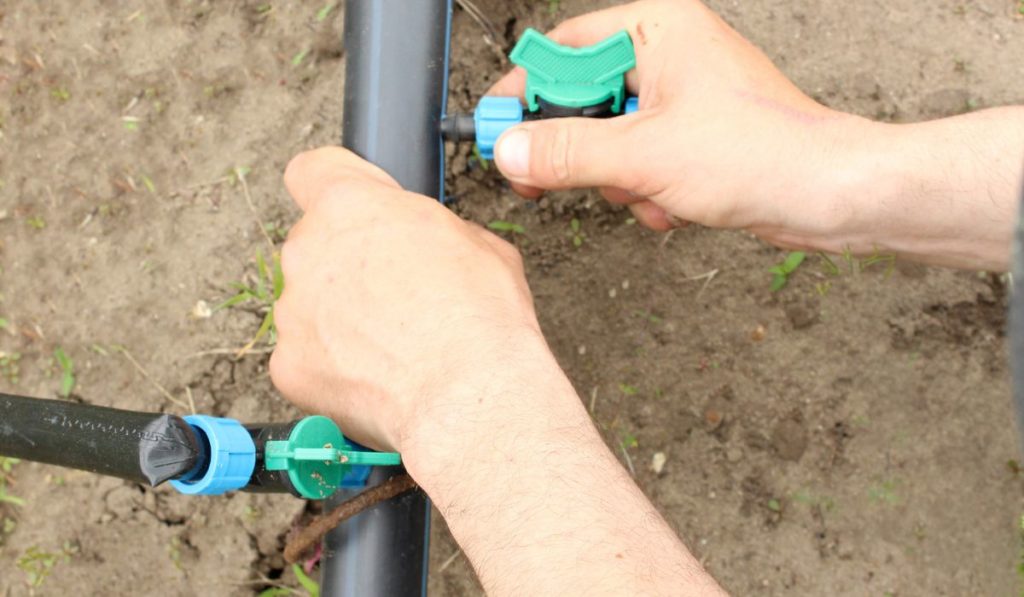
Follow these steps to connect the hose to your drip irrigation system:
- Connect the Drip Adapter
Connect the pressure reducer to the hose bibb or hose. Firmly press the irrigation tubing to attach to the barbed outlet. - Set the Supply Line
Next, you need to lay out your tubing supply line where you want to irrigate. It’s a good idea to ensure the supply line is centered or near the base of plants. Secure the line to the ground with hooked stakes or landscape staples, or simply bury it in mulch or rocks - Install Drip Emitters
Add drip emitters at the right locations for you, and remember you can always add more later. You can add more tubing or more drippers or sprayers or other connections later, but if you add to many you’ll lose pressure and need to rethink things.
Conclusion
The drip system is one of the best for irrigation. It’s ideal if you want to conserve water and save time. You’ll enjoy healthy plants and spend fewer hours dealing with weeds and disease.

